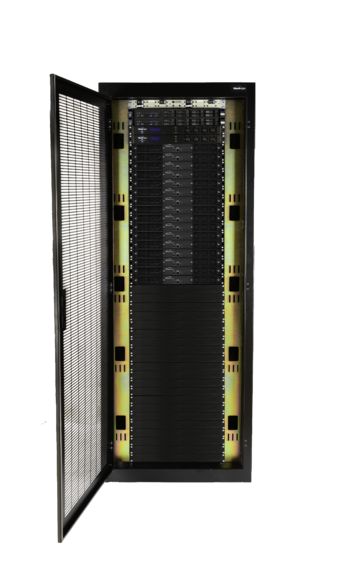TMG7800
(fix number of U) |
|||
| Line 1: | Line 1: | ||
| + | [[Image:7800_straight_front.png|thumb|350px| Front view of TMG7800 VoIP gateway]] | ||
| + | |||
[[Image:Imb_x3250_straight_front.png|thumb|350px| Front view of TMG7800-CTRL VoIP gateway controller]] | [[Image:Imb_x3250_straight_front.png|thumb|350px| Front view of TMG7800-CTRL VoIP gateway controller]] | ||
[[Image:Imb_x3250_straight_back.png|thumb|350px| Front view of TMG7800-CTRL VoIP gateway controller]] | [[Image:Imb_x3250_straight_back.png|thumb|350px| Front view of TMG7800-CTRL VoIP gateway controller]] | ||
| − | |||
The TMG7800 VoIP gateway meets your system requirements by providing you with up to 32,768 universal voice ports and a flexibility to switch between TDM and IP. This capability is enhanced by being able to support a vast selection of signaling protocols, such as SS7, ISDN PRI, SIGTRAN, SIP, SIP-I/SIP-T and H.248, as well as a wide range of media processing codecs across a mix of T1/E1, DS3 and OC3/STM-1 interfaces, all within the same system. | The TMG7800 VoIP gateway meets your system requirements by providing you with up to 32,768 universal voice ports and a flexibility to switch between TDM and IP. This capability is enhanced by being able to support a vast selection of signaling protocols, such as SS7, ISDN PRI, SIGTRAN, SIP, SIP-I/SIP-T and H.248, as well as a wide range of media processing codecs across a mix of T1/E1, DS3 and OC3/STM-1 interfaces, all within the same system. | ||
<br><br> | <br><br> | ||
| Line 20: | Line 21: | ||
=== Characteristics === | === Characteristics === | ||
| − | * | + | *2 to 22U VoIP gateway |
*256 to 32,768 VoIP channels | *256 to 32,768 VoIP channels | ||
*16 to 1024 T1/E1 or 1 to 48 DS3 or 1 to 16 OC3/STM1 | *16 to 1024 T1/E1 or 1 to 48 DS3 or 1 to 16 OC3/STM1 | ||
Revision as of 06:45, 9 September 2016
The TMG7800 VoIP gateway meets your system requirements by providing you with up to 32,768 universal voice ports and a flexibility to switch between TDM and IP. This capability is enhanced by being able to support a vast selection of signaling protocols, such as SS7, ISDN PRI, SIGTRAN, SIP, SIP-I/SIP-T and H.248, as well as a wide range of media processing codecs across a mix of T1/E1, DS3 and OC3/STM-1 interfaces, all within the same system.
The TelcoBridges Tmedia TMG7800 high availability system says it all. This multi-unit VoIP gateway is scalable and 100% redundant ensuring an infallible carrier-grade network. Leveraging redundant integrated VoIP gateway controllers, the TMG7800 delivers core network applications such as VoIP gateway, TDM switching, VoIP hairpinning with transcoding, with advanced call routing and fax over IP. The TMG7800 can also host additional third-party applications such as softswitches and session border controllers locally, further answering the need for device consolidation and convergence. With separate chipsets for media processing and separate processors for call routing and signaling, the TMG7800 VoIP gateway provides full non-blocking capability for up to 32,768 channels per system.
The TMG7800 VoIP gateway provides the ultimate in flexibility, easily scaling to a fully configured capacity of 1024 T1/E1, 48 DS3 or 16 OC3/STM-1 interfaces as service uptake increases, with the ability to mix and match different interface types.
A TMG7800 system consists of four (4) distinct hardware devices:
- TMG7800-CTRL: This is the system's controller. It performs call handling, call routing, CDR collection, and system configuration management. The TMG7800-CTRL also presents the system's Web Portal for OAM&P. The TMG7800-CTRL supports redundnacy.
- TMG7800-TE or -DS3 or -STM1: These are the gateway units that form the TMG7800 system. These gateway units provide the T1, E1, DS3 and/or OC3/STM-1 links and VoIP port capacity required to deliver the desired voice channel capacity. The TMG7800 gateway units are controlled by the TMG7800-CTRL controllers.
- TMG7800-TMS: This device is optional. The TMG7800-TMS is a non-blocking media switch that enables port to port switching between the TMG7800 gateway units. The TMG7800-TMS uses an any-to-any TDM switching fabric to minimize delay and maximize voice quality (unlike other technologies that use a packet technology that introduces delay). The TMG7800-TMS can switch a call terminating on any TMG7800 gateway unit to any other TMG7800 gateway unit. This is particularly useful when the TMG7800 system needs to provide TDM switching services. The TMG7800-TMS also supports redundancy.
Characteristics
- 2 to 22U VoIP gateway
- 256 to 32,768 VoIP channels
- 16 to 1024 T1/E1 or 1 to 48 DS3 or 1 to 16 OC3/STM1
- Redundant AC or DC power supplies
Available configurations
- TMG7800-CTRL, (VoIP server)
- TMG7800-TE16, (16 x T1/E1)
- TMG7800-TE32, (32 x T1/E1)
- TMG7800-TE48, (48 x T1/E1)
- TMG7800-TE64, (64 x T1/E1)
- TMG7800-DS31, (1 x DS3)
- TMG7800-DS32, (2 x DS3)
- TMG7800-DS33, (3 x DS3)
- TMG7800-STM1, (1 x STM1)
- TMG7800-TMS, (media switching fabric)
Each configuration is available with redundant AC or DC power.
See TMG7800 web site to learn more about this product.
